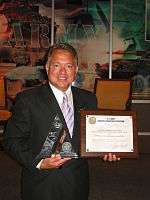Ronnie Barrett
Ronnie G. Barrett (born 1954) is an American firearms manufacturer, the founder of Barrett Firearms Manufacturing of Christiana, Tennessee and the designer of the first .50 caliber rifle Barrett M82 for civilian use.
Ronnie G. Barrett | |
|---|---|
 | |
| Born | 1954 (age 65–66) |
| Alma mater | Murfreesboro Central High School |
| Occupation | CEO Photographer |
| Known for | Barrett Firearms Manufacturing, Barrett M82 |
| Spouse(s) | Donna Rowland Barrett (married 2010-present)[1] |
| Children | Chris Barrett Angela Barrett |
Life and career
Barrett was born in Murfreesboro, Tennessee in 1954, and graduated from Murfreesboro Central High School.[2] He started his career in 1972 as a professional photographer. In 1982, while he owned a photography studio, he got his initial inspiration to create what would become the Barrett signature product. On January 1, 1982, when Barrett was photographing a river patrol gunboat on the Stones River near Nashville, Tennessee, he created an award-winning picture that made him start thinking about the .50 caliber cartridge because of two Browning machine guns mounted prominently on that boat.[3]
Since no commercially available .50 caliber rifle existed at that time, he decided to make a semi-automatic weapon.[4] With no background in manufacturing or engineering, Barrett sketched a cross-sectioned, full-size rifle, adding different components to it. Once he decided on the concept, he approached some machine shops with his drawings. They told him that if his ideas were any good, someone smarter would have already designed it.[2] However, this did not diminish his determination.
A few days later, Bob Mitchell, a tool and die maker and machinist in Smyrna, Tennessee, agreed to help. After their regular job responsibilities, the men would start working on Barrett’s ideas, sometimes laboring together all night in a one-bay garage using a small mill and lathe. Barrett also found support from a sheet metal fabricator who allowed him to visit the owner’s shop and work directly with one employee, Harry Watson. The resulting gun was the shoulder-fired Barrett rifle, which was created in less than four months.[5]
While fine-tuning the first prototype rifle, Barrett began designing a second prototype that featured an improved and sleek exterior and other improvements learned from the first prototype. He made a video of the first prototype being fired, then prepared the second prototype so it would sit on a table. He displayed the latter at a Houston, Texas, gun show where three people gave him deposits to make a rifle for them. With a limited amount of money, Barrett set up a small shop at his residence in a gravel-floored garage. He began by building a batch of 30 rifles, mainly because the two wooden gun racks he made in his father’s cabinet shop held 15 rifles each.[3]

Using his hand-drawing of the new rifle, he placed an advertisement in Shotgun News and soon sold-out the first batch. Barrett was contacted by the CIA who purchased a number of rifles for the Afghan Mujahideen for use in their war against the Soviet Union.[4]
Barrett married former Tennessee State Rep. Donna Rowland during 2010.[1]
References
- Murphy, Cat (September 19, 2017). "Remarkable Rutherford Woman: Former State Rep. Donna Barrett means business". Murfreesboro,Post. MSM Publications.
- Barrett Firearms got its start on the dining-room table, Nashville Business Journal, March 14, 2008
- Lewis, Jack (2007). The Gun Digest Book of Assault Weapons. Gun Digest Books; 7 edition. pp. 94–97. ISBN 978-0-89689-498-3.
- Clancy, Tom (1996). Marine: A Guided Tour of a Marine Expeditionary Unit. Berkeley, California: Berkeley Trade. pp. 59–61. ISBN 978-0-425-15454-0.
- Ian V. Hogg, John S. Weeks (2000). Military Small Arms of the 20th Century. Iola, WI: Krause. pp. 399–400. ISBN 978-0-87341-824-9.CS1 maint: uses authors parameter (link)